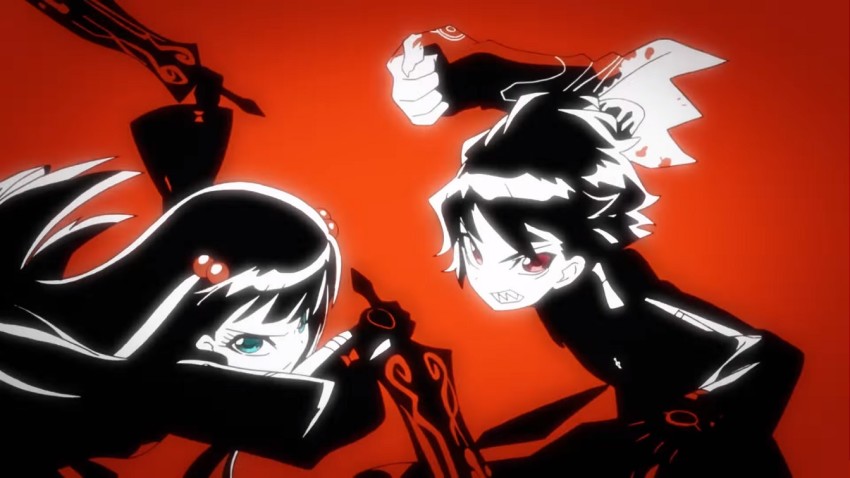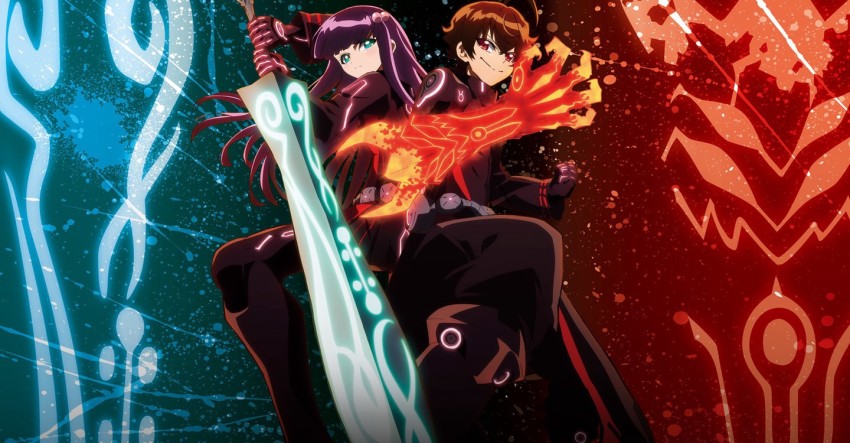Twin Star Exorcists
August 27, 2018 · 0 comments
By Andrew Osmond.
 As anime fans have probably guessed, the “real” world is a thin veneer over a realm of horrid demon monsters ready to gobble us up. Our only protectors are exorcists who go into daily battle on our behalf, wielding spells and charms as their armour. Twin Star Exorcists focuses on a young boy and girl, both exceptionally talented, but with very dark traumas in their pasts. Similar in many ways, the boy and girl madden and frustrate each other in rom-com style.
As anime fans have probably guessed, the “real” world is a thin veneer over a realm of horrid demon monsters ready to gobble us up. Our only protectors are exorcists who go into daily battle on our behalf, wielding spells and charms as their armour. Twin Star Exorcists focuses on a young boy and girl, both exceptionally talented, but with very dark traumas in their pasts. Similar in many ways, the boy and girl madden and frustrate each other in rom-com style.
And then they’re told it’s their destiny to get married and have a baby who’ll save the world. Bummer.
When Twin Star Exorcists premiered in Japan, it was on the TV Tokyo station at 6.25 in the early evening. In other words, this was a primetime anime show, which broadcasters deemed acceptable viewing for kids in Japan (though not necessarily aimed at them). For this reason, it’s diverting to watch Twin Star Exorcists outside Japan and wonder if it could be shown as “mainstream” family fare on British or US TV, without being censored to ribbons. After all, many of Twin Star Exorcist’s characters look cute and/or wacky. One of them is a funny mascot critter who looks like a long-eared fox. How dark can a show like that really be?
As Freddy Krueger would say, heh heh heh.
Oh, don’t get me wrong. This is a generally upbeat hero show, like Naruto and innumerable other titles from the Shonen Jump stable. Twin Star Exorcists was based on a manga serialised in Jump Square, a cousin of Shonen Jump; the same magazine also serialises the Blue Exorcist manga. The show has plenty of stirring messages, silly comedy – including mildly lewd Accidental Pervert humour when boy bumps into girl – and cool magic fight moves that a grade-schooler could imitate in front of the TV.
It’s just that Twin Star Exorcists is also a show that begins – and we do mean the very opening scene – with a pre-teen boy standing in a blood-spattered burning house, begging forgiveness from his playmates’ huddled corpses. “So much for becoming the strongest exorcist!” he declares. Yes, that’s our hero. It’s not the only shock moment in these first thirteen episodes. A later flashback shows the same character helpless to save his friends from monsters, in a gruesome sequence not far from the notorious Blood-C. There’s also a disturbing villain who presents his victims with hideous no-third-way choices, as if we’d wandered into Saw.
 The little boy we mentioned earlier is Rokuro, one of the two titular Exorcists. In the main story, he’s 14, and in many ways like a normal anime kid: goofy, shouty, accident-prone and full of beans. He goes to middle school, and has a brotherly relationship with Mayura, a sweet, caring girl classmate, though it’s obvious to us in a nanosecond that she wishes their relationship wasn’t quite so pure. Yes, Mayura is a Girl Next Door to a T, who won’t slap Rokuro even when he collides with her bosom in the opening minutes.
The little boy we mentioned earlier is Rokuro, one of the two titular Exorcists. In the main story, he’s 14, and in many ways like a normal anime kid: goofy, shouty, accident-prone and full of beans. He goes to middle school, and has a brotherly relationship with Mayura, a sweet, caring girl classmate, though it’s obvious to us in a nanosecond that she wishes their relationship wasn’t quite so pure. Yes, Mayura is a Girl Next Door to a T, who won’t slap Rokuro even when he collides with her bosom in the opening minutes.
Unfortunately for Mayura, she’s not the girl who’s (allegedly) predestined to marry Rokuro. That would be Benio, an intensely severe young exorcist from Kyoto, also 14. Summoned to Tokyo by the exorcist authorities, she doesn’t even get there before she has to fight a horde of demons, called “Kegare” or “impurities”, which attack her train. To protect ordinary people, exorcists like Benio enter the Kegare’s turf to fight. This battleground is a crimson dimension called Magano (“Field of Misfortune”) which looks like a ruined mockery of our own world. Here the Kegare appear as toothy black trolls, some Titan-sized, giggling like spiteful children.
Following her battle, Benio literally falls into Rokuro’s world – a “girl from the heavens” moment a la Miyazaki’s Laputa. After they get dunked in a river, Rokuro tries to help Benio find her destination, but he only convinces her that he’s a scatterbrain. But then there’s another Kegare attack and Benio is astonished to see that Rokuro is not only an exorcist, but a massively strong one, with power that she’s coveted since childhood. And she glimpses another Rokuro under the goofball, a boy who’s wounded, angry, and who sees his powers as nothing but a curse….
It would be easy to compile a list of all the elements of Twin Star Exorcists that we’ve seen before, and squash the show on that basis. But it’s briskly, confidently told, with the interesting twist of a protagonist who used to be exactly like Naruto, Luffy et al – that is, a kid convinced that he could conquer the world – but who threw it all away after a horrendous tragedy. The details of what happened are only revealed several episodes in; again, some of the story elements are familiar, but merged in a way that packs an emotional punch, and permanently changes how Rokuro and Benio see each other.
Many episodes on this volume are lighter, of course. There’s an especially amusing one when the kind Mayura becomes curious about Benio – who’s now enrolled at the local school – and ends up convinced that she’s a teen hoodlum. Considering how exorcists wander around looking for fights, it’s an easy mistake to make! And the later episodes on this volume introduce a sultry female super-exorcist called Subaru. She dresses as a blond big-hatted lady, a Goth Lolita in white, who plays naughty tricks to school impressionable characters in the ways of love. Perhaps it’s not coincidental that Subaru is voiced in Japanese by the popular actress Miyuki Sawashiro, whose other roles include Fujiko in the Lupin the Third franchise.
But action fans shouldn’t worry. This first volume of Twin Star Exorcists culminates in a really big, emotionally fraught battle, preparing a new phase of the story for Volume Two…
Andrew Osmond is the author of 100 Animated Feature Films.
Twin Star Exorcists is released in the UK by Anime Limited.
Leave a Reply